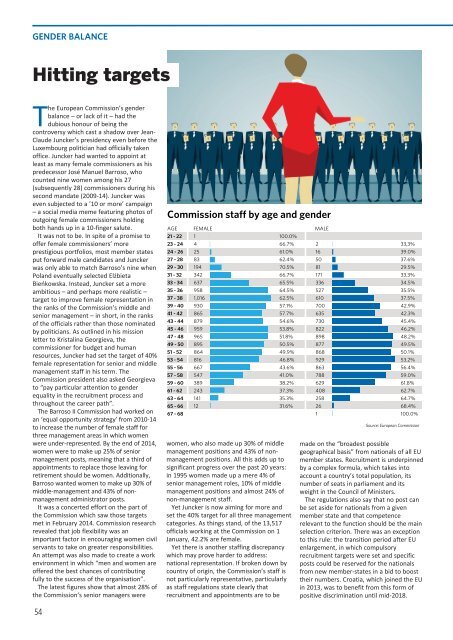Commission-companion-full
Commission-companion-full
Commission-companion-full
You also want an ePaper? Increase the reach of your titles
YUMPU automatically turns print PDFs into web optimized ePapers that Google loves.
GENDER BALANCE<br />
Hitting targets<br />
The European <strong>Commission</strong>’s gender<br />
balance – or lack of it – had the<br />
dubious honour of being the<br />
controversy which cast a shadow over Jean<br />
Claude Juncker’s presidency even before the<br />
Luxembourg politician had officially taken<br />
office. Juncker had wanted to appoint at<br />
least as many female commissioners as his<br />
predecessor José Manuel Barroso, who<br />
counted nine women among his 27<br />
(subsequently 28) commissioners during his<br />
second mandate (200914). Juncker was<br />
even subjected to a ’10 or more’ campaign<br />
– a social media meme featuring photos of<br />
outgoing female commissioners holding<br />
both hands up in a 10finger salute.<br />
It was not to be. In spite of a promise to<br />
offer female commissioners’ more<br />
prestigious portfolios, most member states<br />
put forward male candidates and Juncker<br />
was only able to match Barroso’s nine when<br />
Poland eventually selected Elżbieta<br />
Bieńkowska. Instead, Juncker set a more<br />
ambitious – and perhaps more realistic –<br />
target to improve female representation in<br />
the ranks of the <strong>Commission</strong>’s middle and<br />
senior management – in short, in the ranks<br />
of the officials rather than those nominated<br />
by politicians. As outlined in his mission<br />
letter to Kristalina Georgieva, the<br />
commissioner for budget and human<br />
resources, Juncker had set the target of 40%<br />
female representation for senior and middle<br />
management staff in his term. The<br />
<strong>Commission</strong> president also asked Georgieva<br />
to “pay particular attention to gender<br />
equality in the recruitment process and<br />
throughout the career path”.<br />
The Barroso II <strong>Commission</strong> had worked on<br />
an ‘equal opportunity strategy’ from 201014<br />
to increase the number of female staff for<br />
three management areas in which women<br />
were underrepresented. By the end of 2014,<br />
women were to make up 25% of senior<br />
management posts, meaning that a third of<br />
appointments to replace those leaving for<br />
retirement should be women. Additionally,<br />
Barroso wanted women to make up 30% of<br />
middlemanagement and 43% of nonmanagement<br />
administrator posts.<br />
It was a concerted effort on the part of<br />
the <strong>Commission</strong> which saw those targets<br />
met in February 2014. <strong>Commission</strong> research<br />
revealed that job flexibility was an<br />
important factor in encouraging women civil<br />
servants to take on greater responsibilities.<br />
An attempt was also made to create a work<br />
environment in which “men and women are<br />
offered the best chances of contributing<br />
<strong>full</strong>y to the success of the organisation”.<br />
The latest figures show that almost 28% of<br />
the <strong>Commission</strong>’s senior managers were<br />
<strong>Commission</strong> staff by age and gender<br />
AGE FEMALE<br />
MALE<br />
21 - 22 1 100.0%<br />
23 - 24 4 66.7% 2 33,3%<br />
24 - 26 25 61.0% 16 39.0%<br />
27 - 28 83 62.4% 50 37.6%<br />
29 - 30 194 70.5% 81 29.5%<br />
31 - 32 342 66.7% 171 33.3%<br />
33 - 34 637 65.5% 336 34.5%<br />
35 - 36 958 64.5% 527 35.5%<br />
37 - 38 1,016 62.5% 610 37.5%<br />
39 - 40 930 57.1% 700 42.9%<br />
41 - 42 865 57.7% 635 42.3%<br />
43 - 44 879 54.6% 730 45.4%<br />
45 - 46 959 53.8% 822 46.2%<br />
47 - 48 965 51.8% 898 48.2%<br />
49 - 50 895 50.5% 877 49.5%<br />
51 - 52 864 49.9% 868 50.1%<br />
53 - 54 816 46.8% 929 53.2%<br />
55 - 56 667 43.6% 863 56.4%<br />
57 - 58 547 41.0% 788 59.0%<br />
59 - 60 389 38.2% 629 61.8%<br />
61 - 62 243 37.3% 408 62.7%<br />
63 - 64 141 35.3% 258 64.7%<br />
65 - 66 12 31.6% 26 68.4%<br />
67 - 68 1 100.0%<br />
women, who also made up 30% of middle<br />
management positions and 43% of nonmanagement<br />
positions. All this adds up to<br />
significant progress over the past 20 years:<br />
in 1995 women made up a mere 4% of<br />
senior management roles, 10% of middle<br />
management positions and almost 24% of<br />
nonmanagement staff.<br />
Yet Juncker is now aiming for more and<br />
set the 40% target for all three management<br />
categories. As things stand, of the 13,517<br />
officials working at the <strong>Commission</strong> on 1<br />
January, 42.2% are female.<br />
Yet there is another staffing discrepancy<br />
which may prove harder to address:<br />
national representation. If broken down by<br />
country of origin, the <strong>Commission</strong>’s staff is<br />
not particularly representative, particularly<br />
as staff regulations state clearly that<br />
recruitment and appointments are to be<br />
Source: European <strong>Commission</strong><br />
made on the “broadest possible<br />
geographical basis” from nationals of all EU<br />
member states. Recruitment is underpinned<br />
by a complex formula, which takes into<br />
account a country’s total population, its<br />
number of seats in parliament and its<br />
weight in the Council of Ministers.<br />
The regulations also say that no post can<br />
be set aside for nationals from a given<br />
member state and that competence<br />
relevant to the function should be the main<br />
selection criterion. There was an exception<br />
to this rule: the transition period after EU<br />
enlargement, in which compulsory<br />
recruitment targets were set and specific<br />
posts could be reserved for the nationals<br />
from new memberstates in a bid to boost<br />
their numbers. Croatia, which joined the EU<br />
in 2013, was to benefit from this form of<br />
positive discrimination until mid2018.<br />
54


